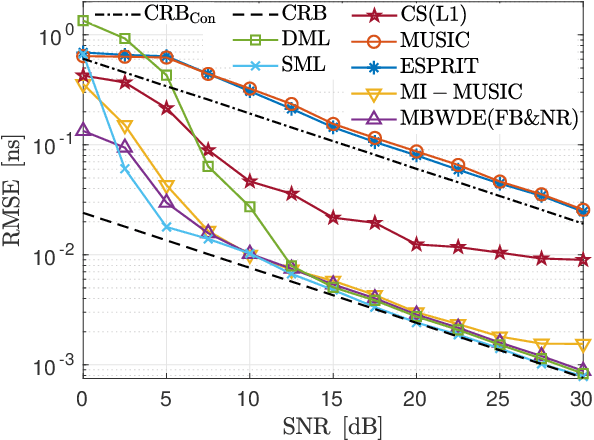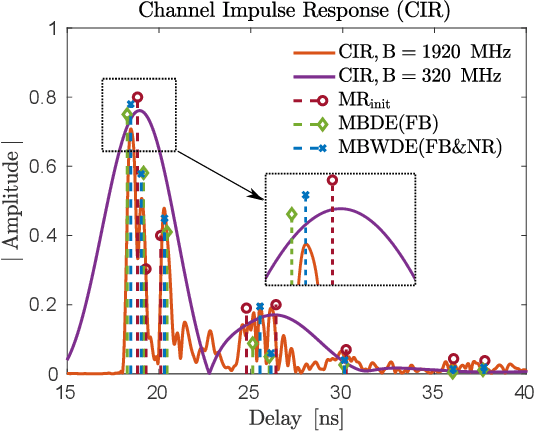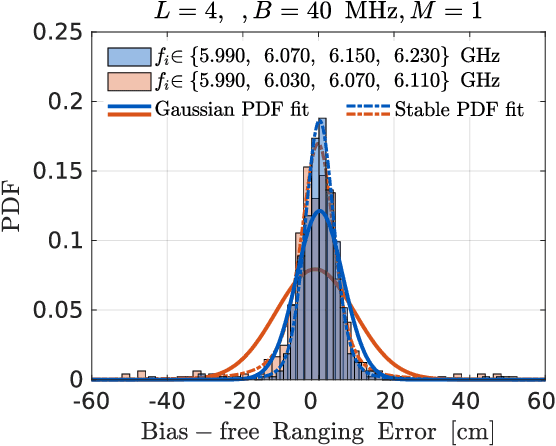Tarik Kazaz
Joint Multiple FMCW Chirp Sequence Processing for Velocity Estimation and Ambiguity Resolving
Dec 05, 2023



Abstract:In FMCW automotive radar applications, it is often a challenge to design a chirp sequence that satisfies the requirements set by practical driving scenarios and simultaneously enables high range resolution, large maximum range, and unambiguous velocity estimation. To support long-range scenarios the chirps should have a sufficiently long duration compared to their bandwidth. At the same time, the long chirps result in ambiguous velocity estimation for targets with high velocity. The problem of velocity ambiguity is often solved by using multiple chirp sequences with co-prime delay shifts between them. However, coherent processing of multiple chirp sequences is not possible using classical spectral estimation techniques based on Fast Fourier Transform (FFT). This results in statistically not efficient velocity estimation and loss of processing gain. In this work, we propose an algorithm that can jointly process multiple chirp sequences and resolve possible ambiguities present in the velocities estimates. The resulting algorithm is statistically efficient and gridless. Furthermore, it increases the resolution of velocity estimation beyond the natural resolution due to its super-resolution properties. These results are confirmed by both numerical simulations and experiments with automotive radar IC.
Delay Estimation for Ranging and Localization Using Multiband Channel State Information
Nov 20, 2021



Abstract:In wireless networks, an essential step for precise range-based localization is the high-resolution estimation of multipath channel delays. The resolution of traditional delay estimation algorithms is inversely proportional to the bandwidth of the training signals used for channel probing. Considering that typical training signals have limited bandwidth, delay estimation using these algorithms often leads to poor localization performance. To mitigate these constraints, we exploit the multiband and carrier frequency switching capabilities of wireless transceivers and propose to acquire channel state information (CSI) in multiple bands spread over a large frequency aperture. The data model of the acquired measurements has a multiple shift-invariance structure, and we use this property to develop a high-resolution delay estimation algorithm. We derive the Cram\'er-Rao Bound (CRB) for the data model and perform numerical simulations of the algorithm using system parameters of the emerging IEEE 802.11be standard. Simulations show that the algorithm is asymptotically efficient and converges to the CRB. To validate modeling assumptions, we test the algorithm using channel measurements acquired in real indoor scenarios. From these results, it is seen that delays (ranges) estimated from multiband CSI with a total bandwidth of 320 MHz show an average RMSE of less than 0.3 ns (10 cm) in 90% of the cases.
* 16 pages, 17 figures, 2 tables, journal
A survey on Machine Learning-based Performance Improvement of Wireless Networks: PHY, MAC and Network layer
Jan 18, 2020



Abstract:This paper provides a systematic and comprehensive survey that reviews the latest research efforts focused on machine learning (ML) based performance improvement of wireless networks, while considering all layers of the protocol stack (PHY, MAC and network). First, the related work and paper contributions are discussed, followed by providing the necessary background on data-driven approaches and machine learning for non-machine learning experts to understand all discussed techniques. Then, a comprehensive review is presented on works employing ML-based approaches to optimize the wireless communication parameters settings to achieve improved network quality-of-service (QoS) and quality-of-experience (QoE). We first categorize these works into: radio analysis, MAC analysis and network prediction approaches, followed by subcategories within each. Finally, open challenges and broader perspectives are discussed.
 Add to Chrome
Add to Chrome Add to Firefox
Add to Firefox Add to Edge
Add to Edge